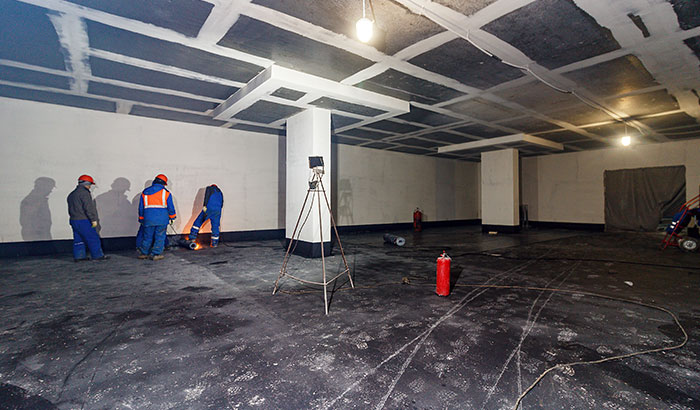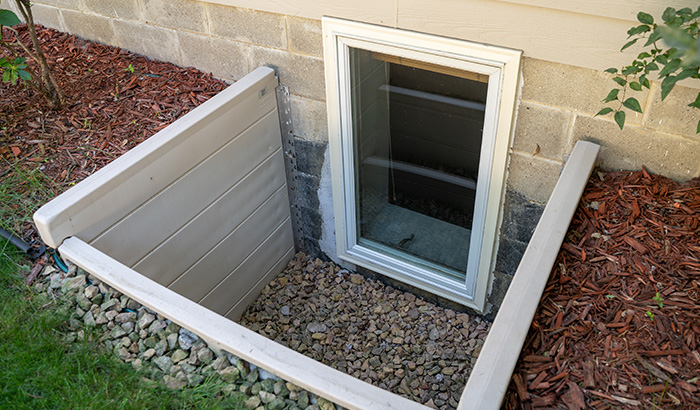Basement windows are ideal for many reasons. They let natural light into an otherwise dark area. They allow an alternate escape route in case of an emergency, and — if done right — they can add to the look of your home (see our stylish window liners here). However, if done wrong, basement windows can cause a handful of issues. The biggest of which is damage from a leak or flood. Keeping your window wells free of water will help protect your home and your wallet.
Learn how to keep water out of your window wells by reading on.
Proper Grading
Proper grading is essential for preventing water from entering your home through the window wells. When the ground surrounding your home slopes away from the foundation, rainwater, and melting snow can flow away from the house, reducing the risk of water damage. This is particularly important for ground-level window wells, which can quickly fill with water if not adequately protected.
If the grading around your home is insufficient, you may notice water pooling in your yard or around your foundation. This can lead to a range of problems, including damage to your foundation, mold growth, and insect infestations. To address these issues, it’s important to have your yard regraded by a professional.
A professional landscaper can assess the grading around your home and determine the best course of action to improve drainage. They may recommend adding soil to create a gentle slope away from the house or installing a drainage system to redirect water away from the foundation. In some cases, it may also be necessary to install retaining walls or other landscaping features to prevent erosion and improve drainage.
In addition to protecting your window wells from water damage, proper grading can also improve the overall appearance of your yard and increase its value. By investing in professional grading services, you can protect your home against water damage and other potential hazards.
Effective Gutters and Downspouts
Properly functioning gutters and downspouts are essential for keeping water out of your window wells. When it rains or snows, water collects on the roof of your home and flows down into the gutters. From there, it is carried through the downspouts and away from the foundation.
If your gutters or downspouts are clogged or damaged, water can overflow and collect near the foundation of your home. This can lead to a range of issues, including water in your window wells, foundation damage, and even structural problems. That’s why it’s important to keep your gutters and downspouts clean and in good condition.
Regular maintenance is key to keeping your gutters and downspouts working effectively. This includes removing debris such as leaves, twigs, and dirt from the gutters and checking for any signs of damage. You should also make sure that the downspouts are directed away from the foundation of your home, ideally at least five feet away.
If you notice any issues with your gutters or downspouts, it’s important to address them as soon as possible. This may involve repairing or replacing damaged sections or installing additional downspouts to improve drainage. In some cases, upgrading your entire gutter system may be necessary to better protect your home from water damage.
By taking care of your gutters and downspouts, you can help ensure that water is effectively diverted away from your home and that your window wells stay dry. This can help prevent a range of issues and protect your home from costly water damage.
Drains in Window Wells
Installing drains in your window wells is an effective way to prevent water from accumulating and seeping into your home. This is particularly important if you live in an area with heavy rainfall or if your home is situated in a low-lying area.
Window well drains are typically installed below the window and are designed to channel water away from your home’s foundation. They are connected to a sump pump or an underground French drain, which moves the water away from the house and towards a suitable drainage location.
The sump pump is an effective solution for areas with frequent heavy rain or flooding. It collects the water from the window well drain and pumps it away from the house, either to a dry well or to a storm drain. French drains, on the other hand, are typically used to direct water away from the foundation of your home by using perforated pipes buried underground. The pipes are surrounded by gravel and other materials that allow water to flow freely, and they direct the water to a designated drainage area.
When installing window well drains, it’s important to ensure they are properly sized and located to manage the water flow effectively. A professional contractor can assess your home and recommend the best drainage solution for your needs. They may also recommend other measures, such as installing a cover over the window well or adding a waterproof membrane to the foundation to further protect your home from water damage.
By installing window well drains, you can help ensure that water is effectively diverted away from your home and that your window wells remain dry. This can help prevent a range of issues, including mold growth, insect infestations, and damage to your foundation.
Clear Out Window Wells
Clearing out your window wells is an essential part of preventing water from accumulating and causing damage to your home. If your window wells are clogged with debris, they will not be able to drain properly, and this can lead to standing water and other issues. In addition, dirty window wells can attract insects, spiders, and rodents, which can be a nuisance and a potential health hazard.
To keep your window wells clear and functioning properly, it’s important to check them regularly and clear out any accumulated debris. This is especially important during the fall when leaves and other organic matter can build up quickly.
Here are four easy steps to cleaning your window wells:
- Remove any debris from the surface of the window well. Use a small shovel or a hand trowel to scoop out any leaves, twigs, or other debris that has accumulated on the surface of the window well. Be sure to dispose of the debris in a compost bin or yard waste bag.
- Check the drain for clogs. If your window well has a drain, check to make sure it’s not clogged with debris. If it is, use a plumber’s snake or a pressure washer to clear the blockage.
- Scrub the interior of the window well. Use a scrub brush and mild detergent to clean the interior of the window well. This will help remove any dirt, grime, or other debris clinging to the well’s sides.
- Rinse with water. After scrubbing, rinse the window well thoroughly with water to remove any remaining soap or dirt. Use a hose or a bucket of water to flush out the well.
By following these four steps, you can keep your window wells clean and functioning properly, which will help prevent water from accumulating and protect your home from water damage. Be sure to check your window wells regularly, especially during the rainy season, and clean them out as needed to ensure they work effectively.
Window Well Covers and Grates
Window well covers and grates effectively prevent water from accumulating in your window wells and protect your home from potential water damage. In addition, they can also help prevent unwanted debris from accumulating in your wells and keep insects, rodents, and other pests out of your home.
Window well covers are typically made from durable materials like polycarbonate or metal, and they are designed to fit securely over your window wells. They are available in various styles and sizes so that you can choose the best option for your needs. Some covers are solid and completely cover the well, while others are designed with small holes or slits to allow for ventilation and natural light.
Window well grates are similar to covers but are typically made from metal bars or other materials that allow for more airflow and visibility. Grates can be a good option if you want to keep your window wells open and visible but still want to prevent debris and water from accumulating.
In addition to preventing water and debris from entering your window wells, covers and grates can also help improve your home’s energy efficiency. By blocking out cold air and preventing heat loss through your basement windows, they can help reduce your heating bills and improve your home’s overall energy efficiency.
When choosing window well covers or grates, it’s important to select the right size and style for your needs. You’ll also want to consider factors like durability, ease of installation, and whether the cover or grate is designed to be removable for emergency escape.
By installing window well covers or grates, you can help protect your home from water damage and improve your property’s overall safety and security. Be sure to consult with a professional contractor if you’re not sure which option is right for your needs or if you need assistance with installation.
Contact Windowell Expressions
Protect your window wells against pooling water with the help of Windowell Expressions. In addition to window well covers and grates, we offer well and foundation liners and replacement window wells. We even offer installation!
When you choose Windowell Expressions, you choose quality work and products, and professional experience. Contact the team of experts at Windowell Expressions for a free estimate today.







